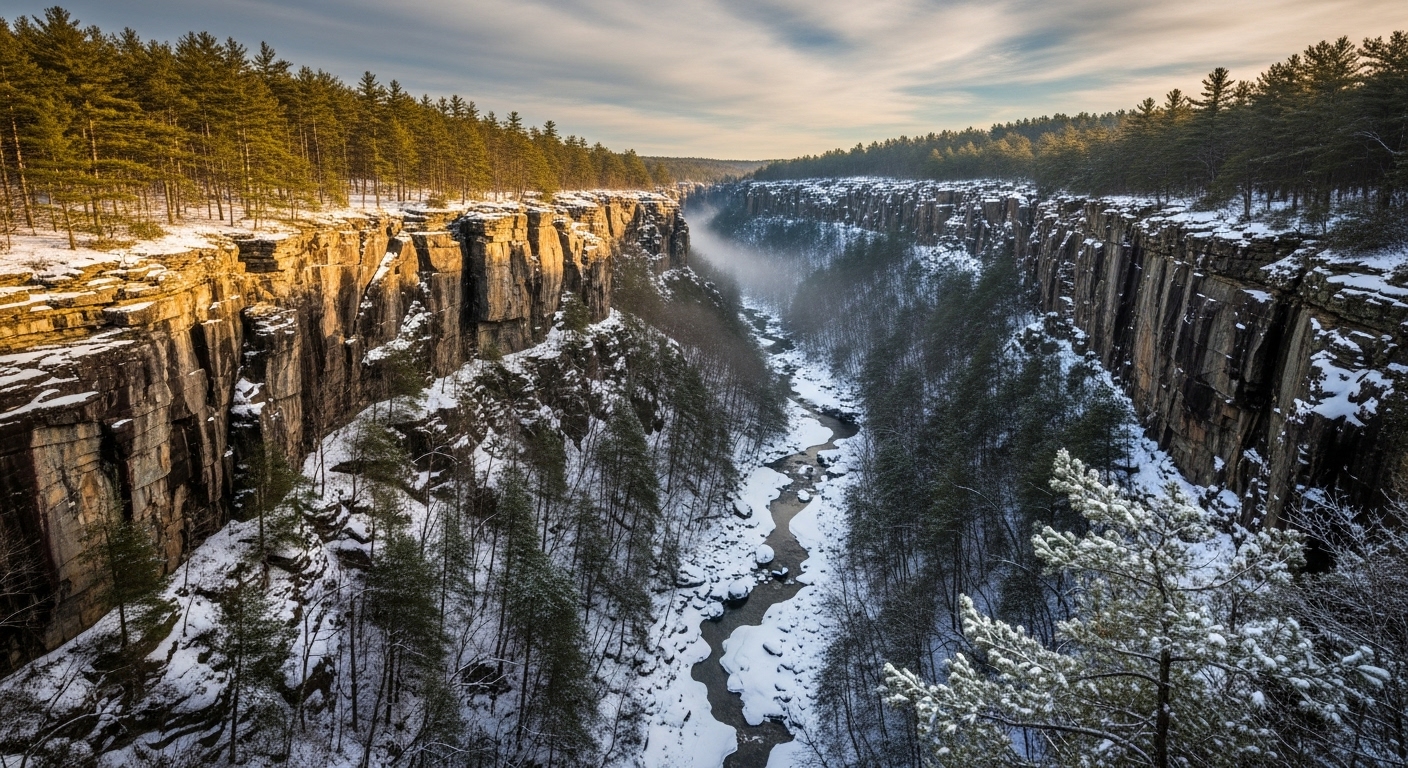A Natural Wonder on the Edge of Penn State Behrend in Erie County, PA
Tucked away in quiet Harborcreek Township, Wintergreen Gorge is one of Erie County’s most cherished secrets. It sits right where Penn State Behrend’s campus transitions into true wilderness. Consequently, this magnificent, six-mile-long chasm is much more than just a park. Fourmile Creek meticulously carved the gorge, creating an open-air natural history museum. It is a favorite escape for geologists, students, hikers, and anyone seeking peace beneath an ancient tree canopy.
The Deep Roots: Unearthing the Gorge’s Formation
To truly appreciate the gorge, visitors must look back into deep time. Indeed, the dramatic walls and steep slopes tell a powerful story of colossal forces and slow, patient erosion.
A Glacial Masterpiece: Time and the Elements
The 250-foot-deep canyon we see today directly resulted from the last Ice Age. About 11,000 years ago, the massive Laurentide Ice Sheet began its retreat northward. The glacier left behind an enormous mantle of gravel, clay, and rock, which geologists call glacial till.
Fourmile Creek, swollen with glacial meltwater, immediately started its slow, inevitable work. First, it steadily cut through the unstable, soft till. Then, the creek exposed the dark, layered Devonian shale bedrock underneath. Furthermore, the creek’s constant erosion deepens and widens the gorge. This process reveals horizontal striations in the rock—original marine sediments laid down millions of years ago. The distinct, tiered look of the gorge walls clearly illustrates differential erosion.
More Than Just a Name: Local Flora
The gorge was simply named for the wintergreen plant (Gaultheria procumbens). This low-growing evergreen shrub thrives in the canyon’s cool, acidic, and shaded environment. Therefore, its distinct, aromatic leaves and bright red berries are a reliable sight along the trails.
🚶 Embracing the Trails: An Immersive Experience
Wintergreen Gorge achieves a great balance of accessibility and ruggedness. In fact, the variety of trails offers something for every outdoor enthusiast, from the casual stroller to the experienced backpacker.
The Higher Paths: Vistas and Views
The main, shared-use paths are generally wide and well-maintained. They often trace the high rim of the gorge, providing breathtaking panoramic vistas. From these points, visitors truly appreciate the scale of the chasm. You can look down at the creek as it snakes like a silver ribbon far below. Thus, these higher trails are ideal for a brisk walk, a morning run, or just enjoying the peaceful silence.
The Lowland Adventure: Creekside Scrambles
For true adventure, steep side trails offer a thrilling descent to the creek bed. The experience is entirely different on the valley floor. Here, the light is diffused, the air is cooler, and the rushing water sounds immediate. Visitors can become part of the landscape:
-
Rock Hopping: Traverse the rocky, sometimes slippery, banks.
-
Wading: Use proper water shoes to wade through the shallow creek.
-
Discovery: Explore smaller, seasonal waterfalls that tumble over shale ledges. The creek bed is a treasure trove for finding small fossils and interesting river-polished stones.
Safety Note: Creekside trails can be slippery and hazardous, especially after rain or snowmelt. Always wear appropriate hiking footwear, and watch for changing water levels.
🌿 A Living Laboratory: Ecology and Education
Wintergreen Gorge functions as a vital, protected Natural Heritage Area. Its complex topography—including steep slopes, a cool valley floor, and wetland pockets—supports many diverse microclimates.
The Penn State Behrend Connection
Penn State Behrend extensively uses the land as a living laboratory. Environmental science and biology programs conduct ongoing research here. They constantly monitor water quality, study plant communities, and manage invasive species like Garlic Mustard. Crucially, this institutional involvement ensures the gorge’s ecological health is actively maintained for future study and enjoyment.
Visitors often spot diverse birdlife, including several species of warblers and woodpeckers. Indeed, the gorge acts as an important migratory corridor. Finally, the health of Fourmile Creek is paramount because it is a vital tributary that feeds into Lake Erie.
Plan Your Visit: Practical Details
The gorge is easily accessible and free to all. The best starting point for most visitors features a dedicated parking area on Cooper Road. Alternatively, you can use one of the well-marked access points on the Penn State Behrend campus (near Trippe Hall or the Prischak parking lot), but always confirm campus visitor parking regulations first.
Whether you seek forest solitude, an exhilarating creekside hike, or a fascinating lesson in geology, Wintergreen Gorge awaits. It remains a precious, unspoiled escape in the heart of Erie County.

